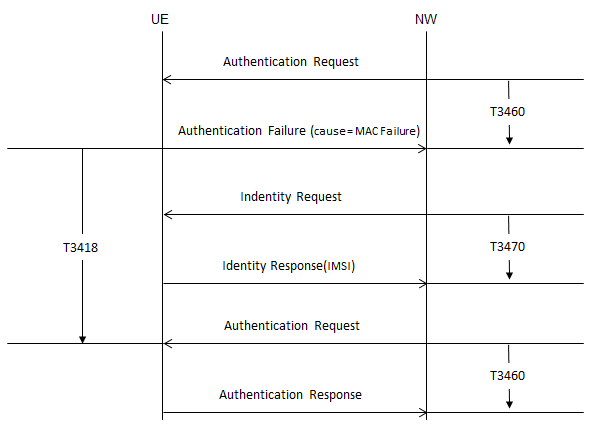|
T3418
Timer T3418 is used in the Authentication Procedure to manage the timing and response to authentication failures, specifically in cases where the UE sends an AUTHENTICATION FAILURE message to the network. It ensures the UE does not remain indefinitely waiting for further actions or responses and helps guide recovery or retry mechanisms.
Timer T3418 ensures:
- Controlled handling of authentication failures to prevent unnecessary retries or prolonged waiting.
- Clear procedures for retrying or aborting authentication challenges.
- Differentiated behavior for emergency services to ensure continuous access to critical connectivity.
- Improved reliability and security by identifying untrustworthy networks or failed authentication attempts in a timely manner.
Key Scenarios Involving T3418
Start of T3418:
-
The UE starts T3418 upon sending an AUTHENTICATION FAILURE message to the network. This failure could be due to issues such as:
-
AUTHENTICATION FAILURE messages indicate that the UE cannot process the received authentication challenge.

Actions While T3418 is Running:
- If the UE receives a new AUTHENTICATION REQUEST message while T3418 is running:
- The UE stops T3418 and processes the new authentication challenge.
- If the AUTHENTICATION REQUEST is invalid (e.g., MAC or SQN cannot be resolved), the UE starts the process again, either retrying authentication or proceeding based on the specific failure scenario.
Expiry of T3418:
- If T3418 expires without receiving a valid response or a new AUTHENTICATION REQUEST:
- The UE considers the network to have failed the authentication check.
- The UE requests the release of the RRC connection and may treat the active cell as barred.
Handling Consecutive Authentication Failures:
- If the UE experiences three consecutive authentication failures (e.g., due to MAC failure, synch failure, or unacceptable authentication challenges) while T3418 is running:
- The UE treats the network as untrustworthy.
- It proceeds to release the connection and treats the cell as barred.
Special Cases for Emergency Bearer Services:
- If the UE has an active PDN connection for emergency services or is establishing one:
- The UE does not treat the network as having failed even if T3418 expires.
- The UE continues using the current security context.
- Non-emergency EPS bearer contexts are deactivated, and the UE remains attached for emergency services only.
Recovery Scenarios:
- Upon receipt of a valid AUTHENTICATION REQUEST message before T3418 expires:
- The UE stops T3418 and resumes the authentication procedure.
- If the network initiates a SECURITY MODE COMMAND before T3418 expires:
- The UE stops T3418 and transitions to the security mode control procedure.
|
|
